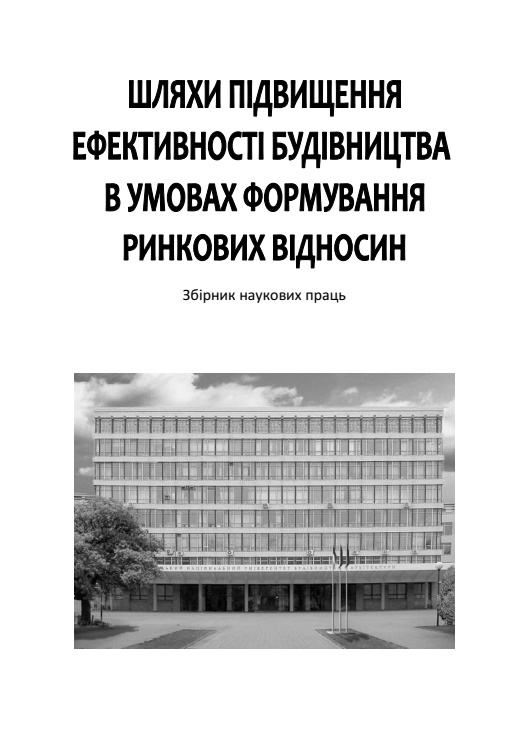Risk management in the design of the organization and technology for the construction and their implementation
DOI:
https://doi.org/10.32347/2707-501x.2021.48(1).124-137Keywords:
initial risk, risk analysis, risk management plan, risk identification, compacted building, risk registerAbstract
Risks are inevitable in any construction project. Risk management methodology is used to eliminate or mitigate their consequences in construction project management. Risk management involves the establishment of risk awareness, integration of basic principles of risk policy and organizational integration. This allows you to actively prepare the project for the inevitable problems and increase transparency. This is an ongoing process throughout the project life cycle, as the risks will be constantly changing. Risk management is the process of identifying, assessing and responding to risks, so it is important to work as an integrated project team from the first phases to identify risks and effectively deal with them when they arise. The benefits of the process are a clearer understanding of the specific risks associated with the project, supported by solutions through detailed analysis and accumulation of data that can be used to manage risks in the future.
Ineffective implementation of risk management is often due to the lack of formalized procedures, lack of continuity in different phases of the project and inadequate integration of knowledge management and interaction between processes and parties.
The article reveals the importance of identifying risks at the very first stage, which allows to reduce the problems during their detection. Attention is paid to risk analysis and risk management at all stages of the project. This is especially important when building in compacted buildings.
A risk management plan is proposed, which provides timely identification and identification of potential problems and should be integrated into the project, from conceptual design to operation with extension to each stage. It should be based on principles such as risk identification, risk assessment, risk response and risk monitoring. The element of risk management algorithm is considered in more detail - identification of initial risks by creating and using a risk register, especially in the conditions of compacted construction.
References
Керування ризиком. Методи загального оцінювання ризику: ДСТУ IEC/ISO 31010:2013 (IEC/ISO 31010:2009, IDT). [Введенно в дію 01.07.2014]. К.: Мінекономрозвитку України. [Електронний ресурс]. – 2014. – Режим доступу: http://online.budstandart.com/ua/catalog/doc-page.html?id_doc=66723
Організація будівельного виробництва: ДБН А.3.1-5:2016. [Введенно в дію 01.01.2017]. К.: Мінрегіонбуд України. [Електронний ресурс]. – 2016. – Режим доступу: http://online.budstandart.com/ua/catalog/doc-page.html?id_doc=64312
Tkachenko V., Klymchuk М., Tkachenko I., Ilina T. Risk management system references in construction. Research Papers in Economics and Finance. 4 (1) 2020, рр. 21-30. https://doi.org/10.18559/ref.2020.1.2
Pialles T. (2017). Study of the Coherences and Dependencies between Quality and Risk Management, within the Construction Industry. [Електронний ресурс]. – Режим доступу: https://repositorio.unican.es/xmlui/bitstream/handle/10902/12447/PIALLES%20-.pdf?sequence=1
Nguyen P.T., Nguyen P.-C. (2020). Risk Management in Engineering and Construction A Case Study in Design-Build Projects in Vietnam. Engineering, Technology and Applied Science Research. 10(01). Рр. 5237-5241. DOI: 10.48084/etasr.3286
Zavadskas E.K., Turskis Z. & Tamošaitiene J. (2010). Risk assessment of construction projects. Journal of Civil Engineering and Management. 16:1. Pp. 33-46. DOI: 10.3846/jcem.2010.03
Islam M.S., Nepal M.P., Skitmore M., Attarzadeh M. Current research trends and application areas of fuzzy and hybrid methods to the risk assessment of construction projects. Advanced Engineering Informatics. Vol. 33, 2017, pp. 112-131. https://doi.org/10.1016/j.aei.2017.06.001.
Кавун В.А. Проектні ризики будівельних підприємств. Ефективна економіка № 9, 2017. [Електронний ресурс]. – Режим доступу: http://www.economy.nayka.com.ua/?op=1&z=5775
Прав Ю.Г. Управління ризиками інвестиційно-будівельних проектів. Вчені записки ТНУ імені В.І. Вернадського. Том 31 (70), № 3, 2020. C. 175-180. DOI https://doi.org/10.32838/TNU-2663-6468/2020.3/30
Grasso P., Soldo L. Risk analysis-driven design in tunnelling: the state-of-the-art, learnt from past experiences, and horizon for future development. Innovative Infrastructure Solutions. Vol. 2, Issue 1, 49, 2017. https://doi.org/10.1007/s41062-017-0087-2.
Rostami A., Sommerville J., Wong I.L., Lee C. Risk management implementation in small and medium enterprises in the UK construction industry, Engineering. Construction and Architectural Management. Vol. 22, No. 1, 2015, pp. 91-107. https://doi.org/10.1108/ECAM-04-2014-0057
Galinsky O.M., Molodid O.S., Sharikina N.V., Plokhuta R.O. Research of technologies for restoration of the concrete protective layer of reinforced concrete constructions during the reconstruction of the buildings and structures. IOP Conference Series: Materials Science and Engineeringю Vol. 907, Innovative Technology in Architecture and Design (ITAD 2020) 21-22 May 2020, Kharkiv, Ukraine. DOI: 10.1088/1757-899X/907/1/012056
Downloads
Published
How to Cite
Issue
Section
License

This work is licensed under a Creative Commons Attribution 4.0 International License.
Authors who publish with this journal agree to the following terms:
- Authors retain copyright and grant the journal right of first publication with the work simultaneously licensed under a Creative Commons Attribution License that allows others to share the work with an acknowledgement of the work's authorship and initial publication in this journal.
- Authors are able to enter into separate, additional contractual arrangements for the non-exclusive distribution of the journal's published version of the work (e.g., post it to an institutional repository or publish it in a book), with an acknowledgement of its initial publication in this journal.
- Authors are permitted and encouraged to post their work online (e.g., in institutional repositories or on their website) prior to and during the submission process, as it can lead to productive exchanges, as well as earlier and greater citation of published work (See The Effect of Open Access).

